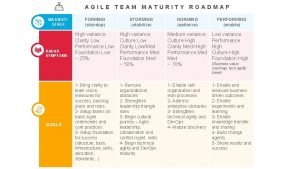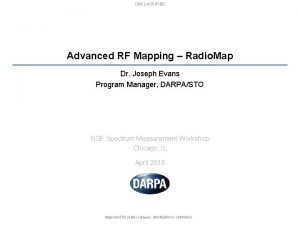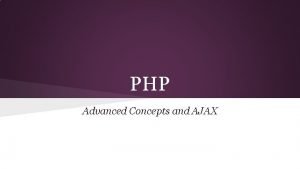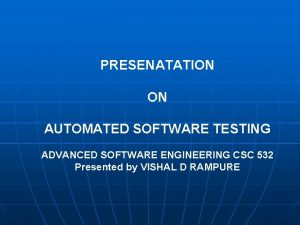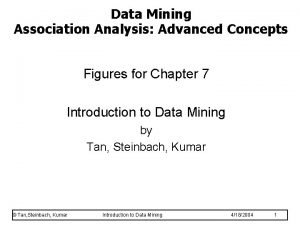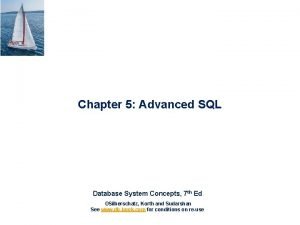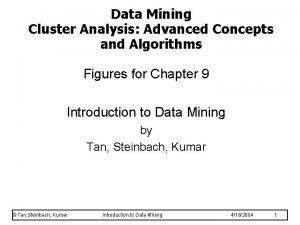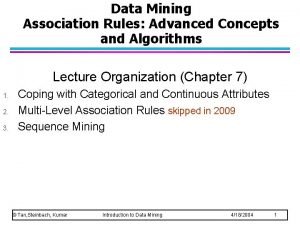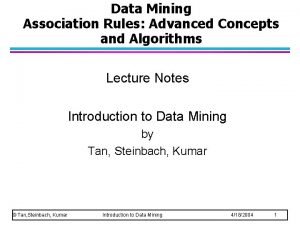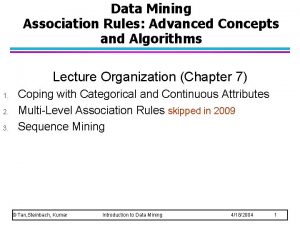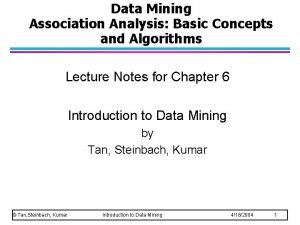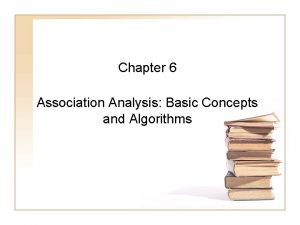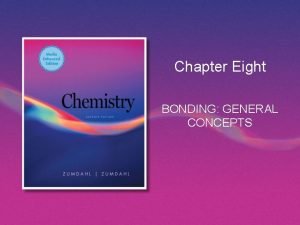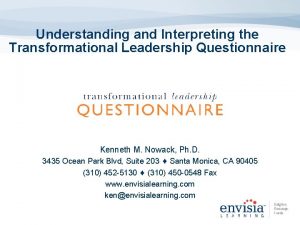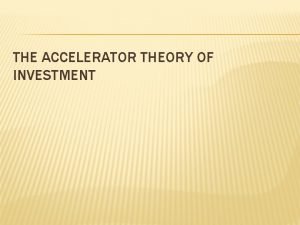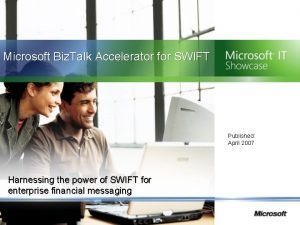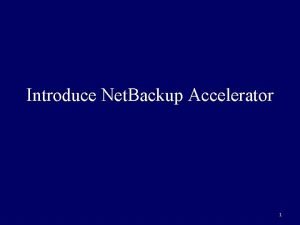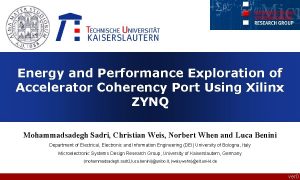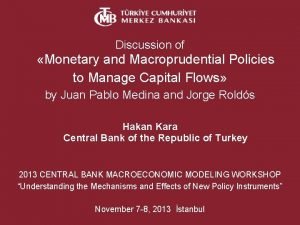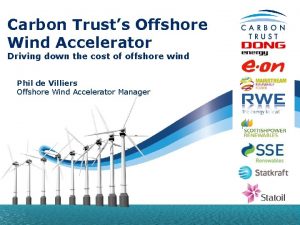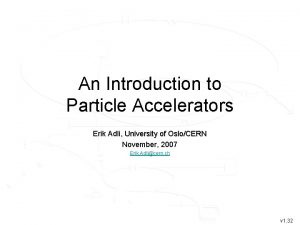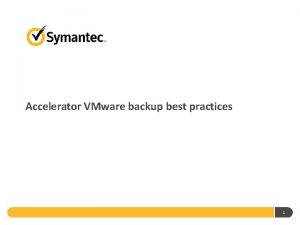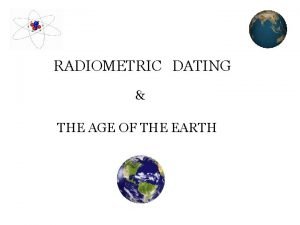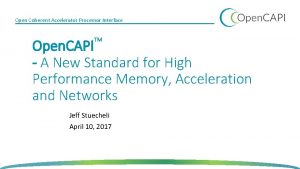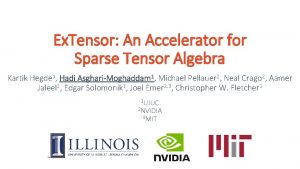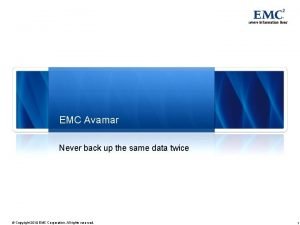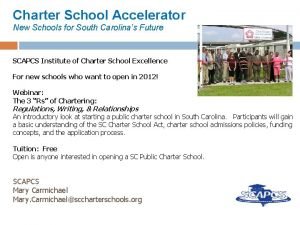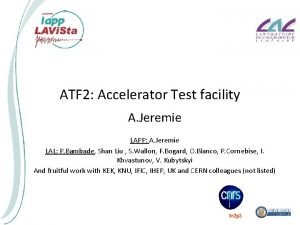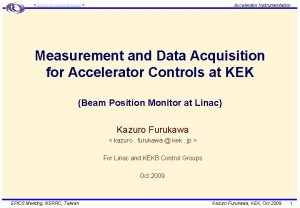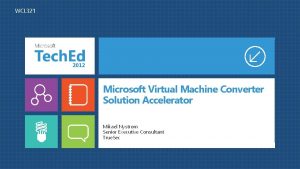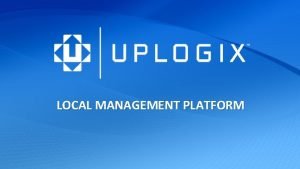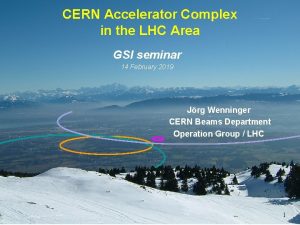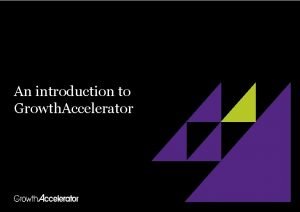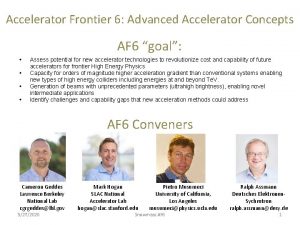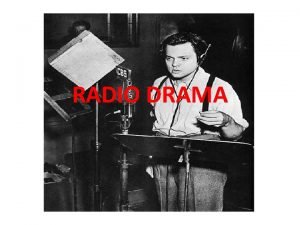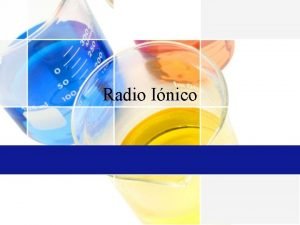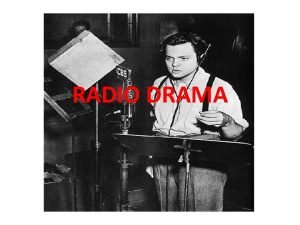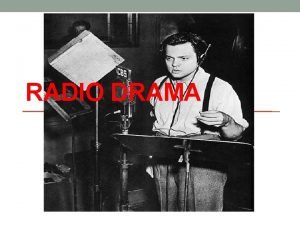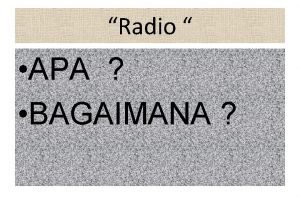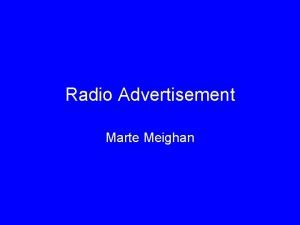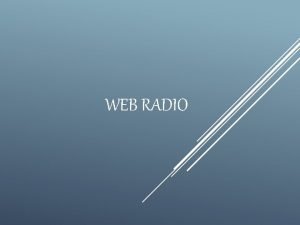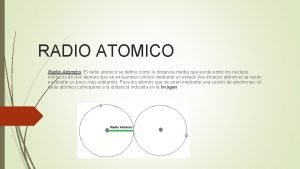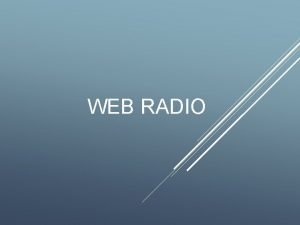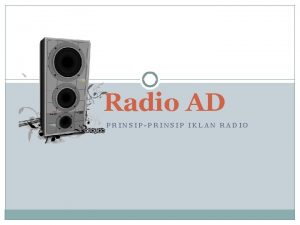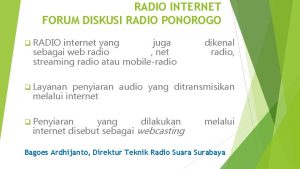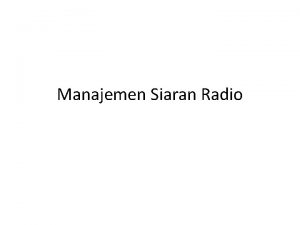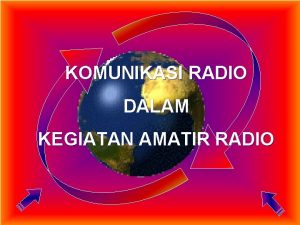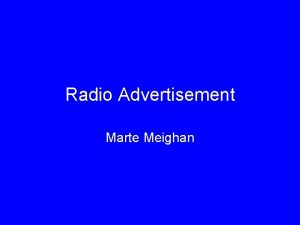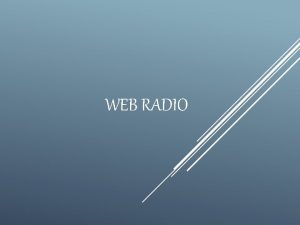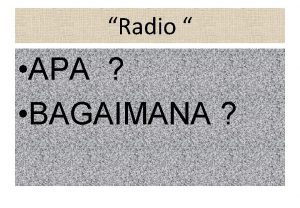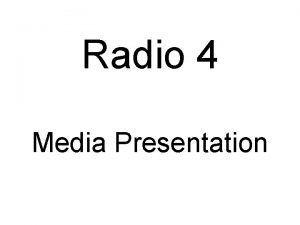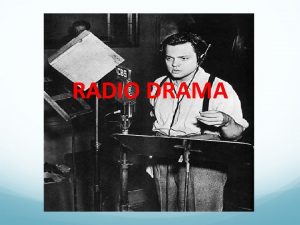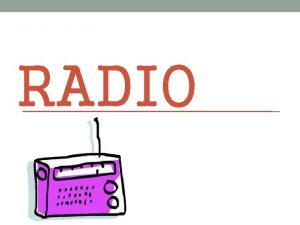General Accelerator RD Roadmaps Advanced Accelerator Concepts Radio






































- Slides: 38

General Accelerator R&D Roadmaps: Advanced Accelerator Concepts Radio Frequency G. C. Blazey Northern Illinois University HEPAP - June 5, 2017

Context: P 5 • P 5 Stated: “The future of particle physics depends critically on transformational accelerator R&D to enable new capabilities and to advance existing technologies at lower cost. ” • P 5 Recommended: – “Align the present R&D program with the P 5 priorities and long-term vision, with an appropriate balance • among general R&D, directed R&D, and accelerator test facilities • and among short-, medium-, and long-term efforts” – “Focus on outcomes and capabilities that will dramatically improve cost effectiveness of mid-term and far-term accelerators. ” • P 5 Suggested: a HEPAP subpanel on accelerator R&D to provide detailed guidance on implementation of accelerator R&D aligned with P 5 priorities.

Context: ARD Subpanel • Following P 5’s advice, DOE convened the HEPAP Accelerator R&D Subpanel. • ARD Subpanel Executive Summary: ”The Subpanel examined the accelerator R&D that is required to prepare for the future-generation accelerators envisioned by P 5. ” • Recommendation 10. Convene the university and laboratory proponents of advanced acceleration concepts to develop R&D roadmaps with a series of milestones and common down-selection criteria. • The HEP Committee of Visitors has recommended that this process be applied to other components of GARD. • Today, as “facilitator” will review roadmaps for GARDAAC and GARD-RF.

AAC Workshop: Process • • • Convened February 2 -3, 2016 by DOE at this venue. Preceded by focused preparatory workshops. Proceedings very detailed and intense : • Presentation of individual roadmaps for PWFA, LWFA, DWFA. • Talks on synergies between the roadmaps and with global efforts. • Talks on potential early applications, diagnostic needs, simulation needs, and beam issues and challenges related to a collider. • Discussion of individual roadmaps with emphasis on the next 5 -10 years and common challenges. Assumptions: • The primary long-term goal is a multi-Te. V e+e- collider with a timescale set by a TDR in 2035 -2040 timeframe. • As an intermediate goal, a TDR for a potential early application such as an XFEL or gamma-ray source. Workshop report at https: //science. energy. gov/~/media/hep/pdf/accelerator -rdstewardship/Advanced_Accelerator_Development_Strategy_Report. pdf

AAC Workshop: Participants • Attendees: • Expert proponents of LWFA, PWFA, DWFA • Invited accelerator science experts from universities and laboratories • Invited participants: – Thomas Antonsen (Maryland) – Ilan Ben-Zvi (BNL, Stony Brook) – Jerry Blazey (NIU) – Yunhei Cai (SLAC) – Weiren Chou (FNAL) – Michael Downer (Texas-Austin) – Wei Gai (ANL) – Carl Schroeder (LBNL) – Mark Hogan (SLAC) • Other participants: – L. K. Len (DOE) – G. Crawford (DOE) – E. Colby (DOE) – A. Lankford (HEPAP) Chungguang Jing (ANL/Euclid) Chan Joshi (UCLA) Wim Leemans (LBNL) Michael Litos (SLAC) Sergei Nagaitsev (FNAL) James Rosenzweig (UCLA) Andrei Seryi (John Adams Inst. ) Bill Weng (BNL) J. Siegrist (DOE) J. Boger (DOE) K. Marken (DOE) V. Lukin (NSF)

AAC Roadmap Common Challenges • The workshop collaboratively identified a set of unifying, common challenges for the next decade: • Staging: Higher energy* staging of electron acceleration, with independent drive beams, equal energy, and 90% beam capture. • Emittance: Understanding mechanisms for emittance growth and developing methods for achieving emittances compatible with colliders. • Higher energy electron acceleration stage: Completion of a single electron acceleration stage at higher energy. • Positron acceleration: Demonstration and understanding of positron acceleration. • Collider parameter set: Continuous, joint development of a comprehensive and realistic operational parameter set for a multi. Te. V collider, to guide operating specifications for AAC. * ”Higher Energy” means multi-Ge. V for LWFA & PWFA and multiple 100 -Me. V for DWFA

Preliminary Roadmap for Laser Plasma Accelerators 2015 2020 2025 2030 2035 2040 Continuing Invention & Discovery Phase Modeling and simulations with hi-fidelity, high speed codes 10 Ge. V module Positrons 5 Ge. V+5 Ge. V staging Accelerators Phase space shaping, efficiency, diagnostics, tolerances Final focus, cooling, … Prototype Phase Ge. V linac – k. Hz rep rate First applications (radiation sources) Design of concepts for colliders Lasers 50 -100 Ge. V linac(s) – O(1 -10 k. Hz) Collider conceptual design report (CDR) 3 k. W class 30 k. W class Office of Science Collider tech. design report (TDR) 300 k. W class Collider

LWFA: Next Decade • • • 10 Ge. V e-beam single stage 5 Ge. V + 5 Ge. V staging. Positron Beams • FEL Applications • Plasma target / energy recovery • Diagnostics • Simulations

Particle Wakefield Acceleration (PWFA): Roadmap Overview • • Emittance preservation Positron acceleration

PWFA: Next Decade • Throughout the 10 -years: • – LC concept development – Beam dynamics & tolerance studies – Early applications development Program is shaped by availability of facilities. – FACET-II Phase 1 – electrons – FACET-II Phase 2 – positrons – FACET-II w/ external injector • • 10 Ge. V Electron Stage – FACETII will enable next step in gradient and beam quality – FACETII external injector will enable further progress (e and DE) Staging Studies with independent witness beam injector

PWFA: Next Decade • Positrons: FACETII Phase 2 will enable the next step in positron acceleration • Plasma source development.

Dielectric Wakefield Acceleration (DWFA): Roadmap Overview • R&D primarily on dielectric two-beam acceleration: – Several critical technology elements can draw upon CLIC or ILC designs: • Polarized electron and positron sources • Beam delivery system and appropriate main-beam parameters at IP – The other critical technology elements are focus of current R&D: • Main (witness) beam acceleration • Drive beam power source • Staging of multiple accelerations structures to higher energy • Goals: – 300 MV/m gradient – Low-cost dielectric structures – Simple drive-beam based power source – Main bunch shaping for high efficiency – High-efficiency klystrons – Multi-fold cost reduction compared to current LC technology

DWFA: Next Decade • • • 2016 -21 – Technology Consolidation Phase – Single stage • GW level RF power from drive beam • 300 MV/m in single stage – High Fidelity Staging • With beam kicker, RF delay lines, two TBA modules per stage 2021 -26 – Technology Integration Phase – Main Beam Source • X-band – 3 -Ge. V Acceleration Facility • High-fidelity, integrated test facility • High-gradient • Staging • LC quality beam Ongoing: – Bunch Shaping • Increase RF-beam efficiency – High Efficiency Klystron • Synergistic with CLIC (and SLAC)

AAC Synergies • Many similarities and parallels in LWFA & PWFA roadmap, considerable physics and required R&D are independent of the driver. – Staging of 1 -10 Ge. V modules – Mitigation of emittance growth due to collisions and ion motion – High-efficiency acceleration – Positron acceleration – Hollow plasma channels for positrons – Mitigation of transverse beam instabilities • Similar timescales for progress • Use of BELLA, FACET-II, ATF, and AWA as appropriate to each study will foster progress. • E. g. : positrons studies at FACET-II; staging and tolerances at BELLA; first studies of plasma lenses at ATF, moving to BELLA & FACET-II for higher energies; AWA for staging and bunch shaping. • Synergies of DWFA with CLIC

RF Workshop: Process • • • Convened February 8 -9, 2017 in Gaithersburg, MD. Preceded by focused preparatory workshops and SLAC and FNAL. Proceedings (also detailed, intense discussions): – Presentation of preparatory workshops & preliminary roadmaps for both SRF and NCRF. – Detailed talks on the status of modeling, international efforts, potential NCRF/SRF synergies beyond HEP, laboratory needs, university roles, user needs, and test facilities at SLAC and FNAL. – Discussion of cross-cuts – Review and integration of the two roadmaps Overarching themes: – Dramatically improve performance and cost by an order of magnitude or more. – Decadal time scale for the roadmap informs improved performance and cost of accelerators now under consideration. Currently discussing a mature draft which forms the basis of this talk.

RF Workshop: Participants • Attendees: • Experts on SRF, NCRF, RF sources, and auxiliary RF systems • Invited accelerator science experts from universities and laboratories • Invited participants: – Sami Tantawi (SLAC) – Seregy Belomestnykh (FNAL) – Cho Ng (SLAC) – Jerry Blazey (NIU) – Erk Jensen (CERN) – Richard Temkin (MIT) – Weiren Chou (FNAL) – Bruce Carlsten (LANL) – Wim Leemans (LBNL) Emilio Nani (SLAC) Anna Grassellino (FNAL) Mathias Liepe (Cornell) Alex Gurevich (Old Dominion ) Robert Rimmer (Jefferson) James Rosenzweig (UCLA) Sergei Nagaitsev (FNAL) Lia Merminga (SLAC) Other participants: – L. K. Len (DOE) – G. Crawford (DOE) – E. Colby (DOE) – V. Lukin (NSF) J. Siegrist (DOE) J. Boger (DOE) A. Lankford (HEPAP) • (Apologies to anyone missed!)

Integrated Roadmap • • • Decadal integrated roadmap Two main components – RF structures – RF sources & auxiliary systems Themes or cross-cuts for cryogenic or warm RF structure R&D: – Understanding basic physics and processes – Exploring new shapes, materials, and operating regimes.

SRF: High Q • Investigate the physics of RF surface resistance • Explore doping • Examine new materials • Physics of magnetic flux losses

SRF: High Gradient • Fundamental limits • Niobium surface treatment and doping • New materials

NCRF: New Structures • Advanced topologies, materials and manufacturing. • New temperature and frequency operating regimes.

RF Sources Explore discrete architectures (multi beam klystron) , distributed architectures (radial klystron), and energy recovery concepts to reach high perveance while operating at lower voltage and higher efficiency.

RF: Auxiliary Systems • • • Electron sources Higher Order Mode damping Power couplers Fast frequency tuners for SRF cavities Rapidly tunable NCRF cavities.

RF Synergies • SRF/NCRF synergies – Surface physics of the cavity – Novel fabrication methods • Office of Science synergies – Nuclear physics (ATLAS, RHIC, FRIB) – Spallation sources (SNS, ESS) – Light sources (LCLS-II, NSLS-II, XFEL…) • Federal Sponsors & Industry – Interrogation – Medicine – Reinvigorating commercial RF sector

As seen by AAC and RF: GARD Computational Needs • A strong modeling program is a critical component of R&D progress. • Requirements: – Development of personnel and of computational teams – Development of new multi-scale models and algorithms – Exploitation of new processor architectures • Addressing these requirement is itself a challenge.

Closing Comments • • The Advanced Accelerator Concepts and Radio Frequency communities invested significant time and effort to develop integrated, comprehensive, and detailed roadmaps. Roadmaps responsive to – P 5 request for alignment of R&D with priorities and improved cost and operation. – ARD request for detailed milestones and goals. AAC roadmap identifies and addresses five common challenges for LWFA, PWFA, DWFA: a higher energy stage, emittance control, acceleration stages, positron acceleration, maintenance of a collider parameter set. RF roadmap addresses performance and cost goals through a focus on SRF and NCRF accelerating structures and RF and auxiliary systems. (For details consult your local accelerator experts)

ARD GARD-AAC Recommendations • Recommendation 7. Vigorously pursue particle-driven plasma wakefield acceleration of positrons at FACET in the time remaining for the operation of the facility. Be-tween the closing of FACET and the operation of a follow-on facility, preserve the momentum of particle-driven wakefield acceleration research using other facilities. • Recommendation 8. Continue to support laser-driven plasma wakefield acceleration experiments on BELLA at the current level. • Recommendation 9. Reduce funding for direct laser acceleration research activities. • Recommendation 10. Convene the university and laboratory proponents of advanced acceleration concepts to develop R&D roadmaps with a series of milestones and common down-selection criteria

ARD GARD-RF Recommendations • • • Recommendation 4. Direct appropriate investment in superconducting RF R&D in order to inform the selection of the acceleration technology for the multi-MW proton beam at Fermilab. Recommendation 6. Increase funding for development of superconducting RF (SRF) technology with the goal to significantly reduce the cost of a ~1 Te. V energy upgrade of the ILC. Strive to achieve 80 MV/m accelerating gradients with new SRF materials on the 10 -year timescale. Recommendation 11. Continue research on high-efficiency power sources and high-gradient normal conducting RF structures. Recommendation 12. Make NLCTA available for RF structure tests using its RF power and beam sources. Recommendation 13. Focus normal conducting RF R&D on developing a multistage prototype based on high-gradient normal conducting RF structures and high-efficiency RF power sources to demonstrate the effectiveness of the technology for a multi-Te. V e+e- collider.

LWFA: Decadal Laser Roadmap • Laser R&D cannot be overlooked, technological progress essential • 30 k. W, k. Hz class laser represents an appropriate next step.

LWFA Update • • Modeling and simulations: novel algorithms resulting in higher speed modeling codes, EXASCALE project funded for developing tools to carry out start-to-end modeling of a 1 Te. V laser plasma based colliders 10 Ge. V module: experimental demonstration of dynamic shaping of plasma channels in capillary discharges with laser heater pulse to provide guiding of high intensity laser pulses at lower plasma densities than previously achieved. Designed, built and operated 20 cm long monolithic capillary discharges, another key step towards higher energies. Experiments underway at BELLA towards 10 Ge. V with these significant new developments and preliminary results are very promising. Staging: two independently powered modules at 100 Me. V per stage were demonstrated) and a design for staging at 5 Ge. V+5 Ge. V was completed. FWP submitted to DOE for second beamline on BELLA to enable experiment. Phase space shaping, efficiency, diagnostics, tolerances: demonstrated a reliable, tunable injector based on gas jet with knife blade first emittance measurement of two different injection techniques Design of concepts for colliders: studied impact of ion motion in plasmas for ultra-intense electron beams; analyzed beam-breakup (BBU) instability and found new method for stabilization BBU was seen as a potential roadblock but a viable solution has emerged. Applications: two new lasers (100 TW class) and beamlines under construction towards a laser plasma accelerator driven XUV free electron laser and a tunable gamma ray source High average power demonstrator (k-BELLA): organized workshop with national and international experts and solid approach(es) have been identified for the near future 3 k. W system as well as for future 10's to 100's of k. W average power collider class lasers with high wallplug efficiency.

PWFA Update • FACET successfully finished its final run in April 2016 & published several key new results: – Investigated head-erosion mechanism mitigation to enhance energy extraction from drive bunch – Demonstrated a Positron Beam-Driven Hollow Channel Plasma Wakefield Accelerator – Mapped the longitudinal field structure within non-linear plasma wake to inform emittance preservation studies – Demonstrated record performance (gradient, energy gain, efficiency) for dielectric wakefield accelerators • Data analysis and high-impact publications in preparation or out for review on: – Laser-triggered injection in electron-beam driven plasma wakefield accelerators - important for studying emittance preservation and developing first off-ramp applications – Acceleration of a trailing positron bunch in a plasma wakefield accelerator - first measurements of positron acceleration spanning non-linear to quasi-linear regimes to identify optimum regime for positron PWFA and LWFA • Planning for FACET-II as a community resource with 3 rd annual science workshop in October 2017

DWFA Update • Single stage – 11. 7 GHz Metallic structure • (Gradient continues to increase over last year) • 300 MW RF (drive beam power generation • 150 MV/m (main beam acceleration) – 26 GHz Dielectric structure • (TBA demonstrated for first time in 26 GHz dielectric) • 300 MW RF (drive beam power generation • 150 MV/m (main beam acceleration) • High Fidelity Staging – Fast kicker: • design completed, • in fabrication, – RF delay lines: • under construction, – Two TBA modules for both stages – Structures: • in-hand – Staging Beamline: • under design AWA User Facility Program • Adding many user’s: (e. g. UCLA PWFA, US-Japan FNAL/NIU, etc. ) •

DWFA: Applications

Alignment with Future Accelerators

SRF Common Roadmap Elements • New Materials, Films, and Multilayers: • Development of Nb 3 Sn as Practical SRF Material • Field Emission Mitigation • Microphonics and Lorentz Force Detuning Compensation • Novel SRF Cavity Shapes

High Q/Gradient Start of the Art N-doped Anti-Q-slope Standard treatment ~ factor of 3 higher Q at mid field Increase in Q factor of two, increase in gradient ~20% (only single-cell cavities to date) Anti-Q-slope emerges from the BCS surface resistance decreasing with field

Progress on NCRF Gradients

Advance RF Source Concepts/Low Cost & Low Voltage • Discrete Architecture: • Modular-Array Multi-Beam Klystron Multi-beam klystron § Redefining the landscape of multi-beam architectures. • • Simplified, low part count, klystrinos Phase locked Floquet power extraction network • Distributed Architecture: • Radial Klystron Radial klystron § Exploiting a novel geometry to mitigate space charge effects. • Low space charge radially propagating beam • Deflected Beam Amplifier Deflected beam amplifier § Multi-stage power extraction that enables high efficiency X-band operation. • Complete beam-wave synchronism with multi-stage output structure. 3 7

Table 1. Milestones for RF modeling and simulation R&D thrusts. Year 1 -2 Milestone Time domain thermal and mechanical solvers for cavity design; Integration of RF and beam dynamics codes for emittance calculation; Solver components for 2 D modeling of RF sources; Nonlinear eigensolvers for damping calculation; GUI for multi-physics cavity design. 3 -4 Capability for EM mode damping calculation for all boundary conditions; Integration of RF and radiation codes as a coupled system; 2 D large-signal code for RF source design; Parallel RF shape optimization tool; GUI including RF shape optimization tool 5– 6 Coupled time domain thermal and mechanical solver for cavity design; System-level integrated RF and beam dynamics simulation; Tool for analysis of spurious oscillations in RF sources; Nonlinear eigensolvers for dispersive lossy materials; GUI for code integration 7– 8 Capability for microphonics simulation in cryomodule systems; System-level integrated RF and radiation calculation; 3 D large-signal code for RF source design; Parallel multi-physics shape optimization tool; Dissemination of RF source codes 9 - 10 Multi-physics shape optimization of large accelerator systems; End-to-end integrated simulation; Optimization procedures for RF source codes; Performance enhancement of parallel codes on emerging supercomputing platforms; GUI for multi-physics shape optimization tool
 Agile maturity roadmaps
Agile maturity roadmaps Advanced radio mapping
Advanced radio mapping Awin support
Awin support Advanced higher music concepts
Advanced higher music concepts Php advanced concepts
Php advanced concepts Advanced software testing concepts
Advanced software testing concepts Association analysis advanced concepts
Association analysis advanced concepts Advanced sql concepts
Advanced sql concepts Association analysis advanced concepts
Association analysis advanced concepts Association analysis advanced concepts
Association analysis advanced concepts Association analysis advanced concepts
Association analysis advanced concepts Types of attributes in data mining
Types of attributes in data mining Association rules in data mining
Association rules in data mining Association analysis advanced concepts
Association analysis advanced concepts Sf4o lewis structure
Sf4o lewis structure Diferencia entre gran plano general y plano general
Diferencia entre gran plano general y plano general Where did general lee surrender to general grant?
Where did general lee surrender to general grant? Leadership accelerator questionnaire
Leadership accelerator questionnaire Accelerator theory of investment
Accelerator theory of investment Swift biz
Swift biz Netbackup track log location
Netbackup track log location Fiscal policy definition
Fiscal policy definition Accelerator coherency port
Accelerator coherency port Financial accelerator
Financial accelerator Offshore wind accelerator
Offshore wind accelerator Particle accelerator formula
Particle accelerator formula Netbackup vmware backup process flow
Netbackup vmware backup process flow Dating
Dating Open capi
Open capi Extensor: an accelerator for sparse tensor algebra
Extensor: an accelerator for sparse tensor algebra Avamar ndmp
Avamar ndmp Charter network accelerator
Charter network accelerator Accelerator
Accelerator Accelerator
Accelerator Mvmc download
Mvmc download United way social innovation accelerator
United way social innovation accelerator Uplogix 5000
Uplogix 5000 Cern accelerator complex
Cern accelerator complex Growth accelerator coach
Growth accelerator coach
